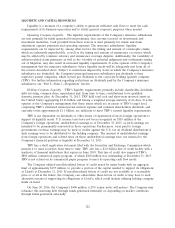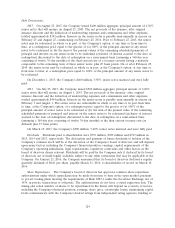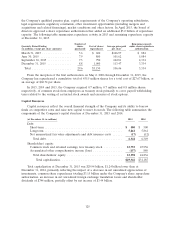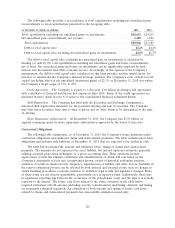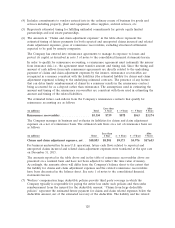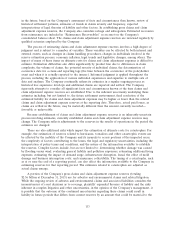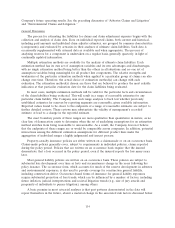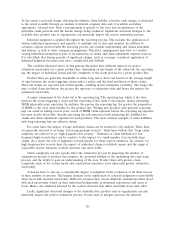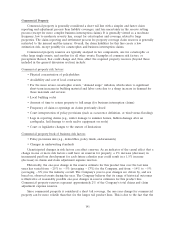Travelers 2015 Annual Report Download - page 131
Download and view the complete annual report
Please find page 131 of the 2015 Travelers annual report below. You can navigate through the pages in the report by either clicking on the pages listed below, or by using the keyword search tool below to find specific information within the annual report.This change does not affect the measurement of the Company’s total benefit obligations as the
change in the service cost and interest cost is completely offset in the actuarial (gain) loss reported for
the period. The change will result in a reduction of the service and interest cost components of net
periodic benefit costs for 2016 of $6 million and $30 million, respectively. The weighted average
discount rates that will be used to measure service and interest cost during 2016 are 4.77% and 3.64%,
respectively, for the domestic qualified pension plan, 4.53% and 3.47%, respectively, for the domestic
nonqualified pension plan and 0.00% and 3.53%, respectively, for the domestic postretirement benefit
plan. The discount rate associated with the service cost component of the domestic postretirement
benefit plan is zero as it is a closed plan and all participants are fully vested. Under the Company’s
prior estimation approach, the weighted average discount rate for both the service and interest cost
components would have been 4.50% for the domestic qualified pension plan, 4.37% for the domestic
nonqualified pension plan and 4.35% for the domestic postretirement benefit plan. The Company will
account for the change in estimation approach as a change in estimate, and accordingly, will recognize
the effect prospectively beginning in 2016.
At December 31, 2015, the Company updated its mortality assumptions for estimating its qualified
pension plan liabilities utilizing a new mortality improvement scale issued by the Society of Actuaries in
October 2015. The adoption of the new mortality improvement scale decreased the projected benefit
obligation by $57 million at December 31, 2015. At December 31, 2014, the Company updated its
mortality assumptions for estimating its qualified pension plan liabilities utilizing a new mortality table
and related improvement scale issued by the Society of Actuaries in October 2014. The adoption of the
new mortality table and related improvement scale increased the projected benefit obligation by
$150 million at December 31, 2014.
The Qualified Plan assets are managed to maximize long-term total return while maintaining an
appropriate level of risk. The Company’s overall strategy is to achieve a mix of approximately 85% to
90% of investments for long-term growth and 10% to 15% for near-term benefit payments with a
diversification of asset types, fund strategies and fund managers. The current target allocations for plan
assets are 55% to 65% equity securities and 20% to 40% fixed income securities, with the remainder
allocated to short-term securities. For 2016, the Company plans to apply an expected long-term rate of
return on plan assets of 7.00%, compared with 7.25% in 2015. The expected rate of return reflects the
Company’s current expectations with regard to long-term returns in the capital markets, taking into
account the pension plan’s asset allocation targets, the historical performance and current valuation of
U.S. and international equities, and the level of long term interest rate and inflation expectations. The
Company’s expected long-term rate of return on plan assets also contemplates a return to more normal
levels of long-term interest rates in the future.
For further discussion of the pension and other postretirement benefit plans, see note 14 of notes
to the consolidated financial statements herein.
Risk-Based Capital
The NAIC has an RBC requirement for most property and casualty insurance companies, which
determines minimum capital requirements and is intended to raise the level of protection for
policyholder obligations. The Company’s U.S. insurance subsidiaries are subject to these NAIC RBC
requirements based on laws that have been adopted by individual states. These requirements subject
insurers having policyholders’ surplus less than that required by the RBC calculation to varying degrees
of regulatory action, depending on the level of capital inadequacy. Each of the Company’s U.S.
insurance subsidiaries had policyholders’ surplus at December 31, 2015 significantly above the level at
which any RBC regulatory action would occur. Regulators in the jurisdictions in which the Company’s
foreign insurance subsidiaries are located require insurance companies to maintain certain levels of
capital depending on, among other things, the type and amount of insurance policies in force. Each of
the Company’s foreign insurance subsidiaries had capital significantly above their respective regulatory
requirements at December 31, 2015.
131



